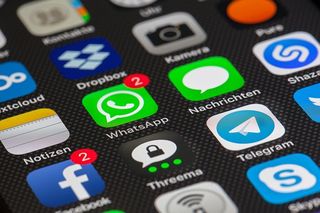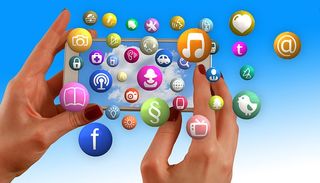Anxiety
Obsessive/Addictive "Tiny Red Dots"
How Product Developers Keep Our Eyeballs Glued to Their Apps
Posted March 11, 2018

Recently John Herrman wrote an insightful article for the New York Times Magazine entitled, “How Tiny Red Dots Took Over Your Life” where he talks about the addictive nature of technology. He makes the point that the “reformists”—people like Tristan Harris of the Center for Humane Technology—are trying to help the situation by appealing to tech companies to change their business model, but he sees no consensus or plan for those reforms. Herrman then focuses on the little red dots—known as badges—that appear at the upper corner of app icons alerting you, enticing you, telling you that you need to open the app to find out what is going on. Sometimes it is just a dot while other times there is a white number on the red dot background (sometimes ringed with a thin yellow line) telling you not only that you are missing out on something but how many “somethings” are awaiting you with just a tiny tap.
When the iPhone opened the app store a decade ago apps had one simple business model: Bring eyeballs to the app and keep them there as long as possible. In-app purchases, gamification, and alerts and notifications were helpful tools to a successful business. The dots were among the earliest alerting tools that iOS gave app developers and boy did they use them. Some apps automatically enabled notifications while others encouraged us to enable them and when we follow suit we found that our smartphones were replete with those tiny red dots.
[sorry, but I just got distracted by a dot on my mail app accompanied by a vibration. As the Beatles said in a Day in the Life, “I just had to look …”. Back in a moment.]
Well, as predicted, that moment took 10 minutes as that email led to me checking my backup Gmail account (mostly for student work) and responding to someone by finding a class assignment and emailing it. While I was doing that another three dots showed up on my Message app and I am finally back to writing. If it sounds tiring, it is and we are all feeling worn down by our tiny red dots.
The dots are not restricted to our phones, although that is where we reside most often. On my MacBook Twitter shows that I have 147 unread tweets (and I only follow 11 neuroscientists) while other web pages beckon me to open them and “catch up” with what I am missing.

What is driving this behavior? There appear to be two camps, one that has determined the driving force is addiction while the other asserting that obsessive anxiety is what makes us return to our devices constantly all day (and night). Addiction and obsession are different processes according to the Diagnostic and Statistical Manual of Mental Disorders. In fact, smartphone or Internet addiction or obsession are not even in the manual although Internet gaming disorder was placed in the appendix of the latest version as warranting further study meaning with more research it may appear in the next version. Anxiety certainly appears in the DSM in many guises but nothing is said relating it to the Internet or smartphone or tiny red dots. In the literature, it is often referred to as FOMO—fear of missing out—or nomophobia—fear of being without your smartphone or being unable to use it.
Biochemically and behaviorally these two driving forces are not the same although people use them interchangeably saying, “I’m addicted to my smartphone” or “I am obsessed with social media” as though they are the same. They are not. Addictions typically feature a series of symptoms including requiring more and more of the addicted object to feel the same pleasure; wanting to cut down but not being successful; neglecting family, friends, work, and school; and developing withdrawal symptoms which are only satisfied by doing the addicted act or using the addictive object. Biochemically, addictions typically involve neurotransmitters such as dopamine and serotonin as part of the dopaminergic system plus other brain chemicals. Basically, dopamine motivates the addictive action with the brain’s desire to have more and more while serotonin is responsible for making us feel happy and satiated and then inhibits the need for more dopamine. The problem is that as with other addictions we constantly need more and more dopamine to get to the point where serotonin tells us we are feeling good.

Anxiety is a completely different system with many neurotransmitters and hormones playing their roles including cortisol, epinephrine, GABA, and others. When those chemicals are released in large enough quantities they induce bodily feelings of anxiety including sweaty palms, queasy feelings, and, in the extreme, fear. Most likely when it comes to issues such as FOMO or nomophobia the chemicals increasingly make us feel as though we are missing out on something important and once we check in we feel better … until the whole process begins again. In our research with young adult college students we find that they check their smartphone every 15 minutes or so on the average and using an app with two groups of college students one year apart we found that in early 2016 they unlocked their phones 56 times a day for a total of 220 minutes or about 4 minutes per unlock. A year later a comparable group unlocked their phones 50 times a day for 262 minutes or more than 5 minutes per unlock. I am currently collecting data on a similar group and fully expect those minutes to once again increase dramatically.
So, are we addicted or obsessed? I would argue that at any minute we fall at some point on a spectrum ranging from totally addicted to totally obsessed. Right now, I have not checked my email for 15 minutes and I am feeling anxious and when I look at my phone I see that I have an email from my younger son and I feel pleasure. It’s a bit of both but our work consistently shows that the anxiety system makes us keep our phones close by and makes us constantly check in.
One culprit is those tiny red dots. They may seem to beckon you and gnaw at you and even bark at you to open that app BUT you don’t need to follow their call. You alone control which dots you see and which you don’t by setting up your notifications for each app. I highly recommend that you check notifications and remove nearly all of them as you will likely not miss out on anything important. On my iPhone, I just went to Settings and then Notifications and checked to see which had the word “off” under their name and which had either sounds or banners or both. On most apps, you can also specify sounds and vibrations. Over the time I have pruned it down to just allowing vibrating notifications from my email (which drives my family crazy), messages, phone calls, and calendar. All others are on “off” although they weren’t always turned off. I used to allow any app to notify me thinking that would make me feel that rush of pleasure and instead the presence of those tiny red dots created a rash of anxiety-promoting chemicals that made me constantly on edge.

In our work, we find that social media is exploding. In our latest study of adults, the typical college student has active accounts on nearly 6 sites that they visit at least once a week and most are accessed daily. If social media is the driving force behind your addiction/obsession move all social media apps to the last page of your home screen and hide them in a folder so that they are not stimuli that drag you into their world.
Incidentally, when the semester ends and students submit their data for the entire semester, I ask them several questions including did you monitor the data (two-thirds say no), half feel that the numbers were higher than they expected and two-thirds are clear that the data would not encourage them to make any changes in their behavior at all.
When I discuss these data in interviews the most common question is “Do you think that we have reached our saturation level and will soon stop looking at our smartphones as often?” Sadly, my answer is that we have not reached the peak yet and I don’t see our obsessive/addictive usage abating any time soon. There are a rash of books out there talking about this issue and many seem to sell quite well. My concern is that the purchasers are not the people who should be paying attention. Younger people don’t appear to read books much and other avenues are needed to encourage them to question their smartphone behaviors. However, all that said, I remain optimistic that the bottom of the pendulum swing is coming soon and then we can start to return to healthier technology use. As I have said often, we are sacrificing our Humanware as we overuse our hardware and software.




